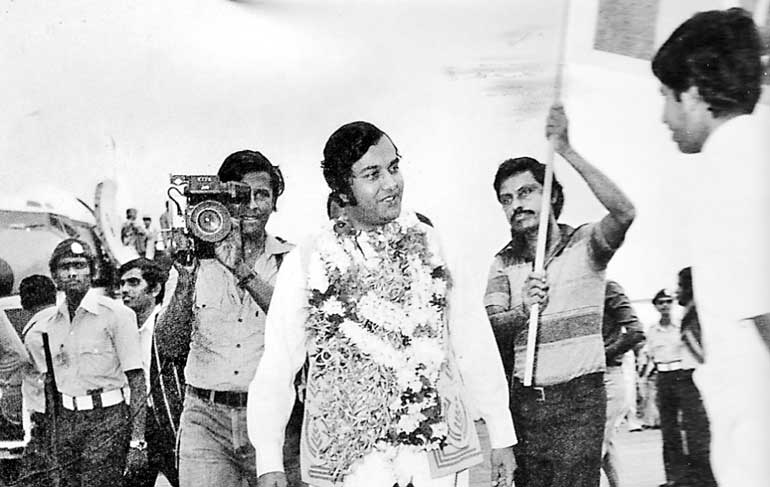Friday Jan 02, 2026
Friday Jan 02, 2026
Saturday, 6 August 2016 00:00 - - {{hitsCtrl.values.hits}}

At least one sports writer – Island’s Rex Clementine – reported that the current Test match played in Galle against Australia is Sri Lanka’s 250th Test in its 35-year Test history. After Sri Lanka was accorded Test status by the International Cricket Council (ICC) on 22 July 1981, the inaugural Test was played in February 1982 at P. Sara Stadium. The Galle Test is certainly a landmark event in the history of Sri Lanka cricket.
The first Test was played exactly 100 years after 100 years since the first international tem visited Ceylon. While that team happened to be a team from England, the first Test was also played against an English team.
Referring to the first-ever team to visit Ceylon, S.S. Perera in the ‘Janashakthi Book of Cricket’ writes that the team was travelling to Australia in the ship ‘Peshawar’ which called at Colombo port on 13 October 1882. The team led by Ivo Bligh played against an All-European XI comprising players from the Colombo Cricket Club (CCC) and the British Garrison in Colombo.
The two-day game started around 4 in the afternoon on the first day and the visitors had scored 155 for 9 decl. by noon the following day. The Colombo team captained by G.J. Jamesin replied with 92 and following on fared poorly losing seven wickets for just 16 runs off 74 balls but managed to play out time for a draw. In the local team were the cricket master at Royal College – Ashley Walker, H.C.P. Bell – who later became the first Archaeological Commissioner – and W.H. Jakson, a civil servant.
The game began to be played on a more organised basis with the formation of the Board of Control for Cricket with retired Civil Servant and ardent cricket enthusiast P. Saravanamuttu as the President. He was Head of the Ceylon Cricket Association (1937-50) and President of the Tamil Union Cricket & Athletic Club (1948-51).
Successive presidents and committees worked hard to get membership of the ICC – International Cricket Conference – later Council, but Sri Lanka was kept out. In 1964 Pakistan suggested an expansion of the ICC in order to include non-Test playing countries, but it was not accepted. By then Sri Lanka was playing with Test-playing nations but the games were identified as ‘Unofficial Tests’.
In 1965, a compromise formula was arrived at by creating a new category called Associate Members. Sri Lanka along with Fiji and USA were the first such members but they did not enjoy all the privileges of Full Members. Each time Sri Lanka’s name was proposed for full membership, it was vetoed by the more powerful members. Thus it became a long wait.
In June 1981, Minister Gamini Dissanayake in the J.R. Jayewardene Government was elected President of the Board and immediately he formulated a plan to develop the game. He was determined to convince the ICC that the country was ready to deliver. At the annual ICC Board meeting in July 1981 he made a strong case for full membership which was accepted unanimously by the membership.
Sri Lanka’s record from 1974 onwards was convincing and when Sri Lanka beat Australia in May 1981 for the first time in a 50-over game (by six wickets with Captain Bandula Warnapura hitting 106), it had sealed its fate. There was no way the ICC could further delay.
No sooner the good news was heard, Ceylon Tobacco hurriedly planned to mark the victory by producing a film on the history of cricket in Sri Lanka. CTC, in fact, was the sole sponsor of cricket at the time. As Manager in charge of Corporate Communications, it fell on my shoulders to handle the film.
Ace cameraman D.B. Nihalsingha was invited to undertake the project and ‘master statistician’ S.S.S. Perera’s assistance was sought to get the relevant information. The climax of the film was to be the triumphant arrival of Minister Dissanayake. There was going to be a hero’s welcome.
Cricket enthusiasts gathered. Cheer leader Percy Abeysekera was at hand. School cricketers provided a guard-of-honour. As the smiling Minister came down the gangway, he was lavishly garlanded. Nihalsinghe captured the airport scene in detail.
Renowned author Michael Roberts in ‘Essaying Cricket’ summed up: “The foundations for Sri Lanka to break through into the ranks of Test-playing nations in the face of obduracy and prejudice among the powerbrokers of some White nations was provided by the performances of its cricketers in England in 1975 and 1979 during the ICC tourney (which they won on both occasions) and each subsequent World Cup. Again, the manner in which the teams matched the Australian team that toured Sri Lanka in 1981 counted for a lot. Support for the cause from A.H. Kardar of Pakistan and Fred Bennett of Australia at ICC Board levels over the years also helped. Nevertheless, Dissanayake’s verbal skills and position helped tip the scales at the critical ICC meeting. One of the principal objections related to ground facilities and as Minister for the Mahaweli Board he was able to assure the doubters that the Government would pitch in to raise infrastructural levels. Indeed, he subsequently twisted the arms of a British engineering firm and others in order to upgrade the Trinity College (his alma mater) grounds to Test-playing capacity.”
The First Test is another story.